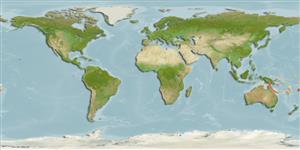Teleostei (teleosts) >
Ophidiiformes (Cusk eels) >
Dinematichthyidae (Viviparous brotula)
Etymology: Diancistrus: Greek, di = two + Greek, agkistron = hook (Ref. 45335); leisi: Named for Jeffrey Leis, Sydney, Australia.
Eponymy: Dr Jeffrey Martin Leis (d: 1949) is a larval-fish biologist and Adjunct Professor at the Institute for Marine and Antarctic Studies, University of Tasmania. [...] (Ref. 128868), visit book page.
More on authors: Schwarzhans, Møller & Nielsen.
Environment: milieu / climate zone / depth range / distribution range
Ecology
Marine; reef-associated; depth range 2 - 17 m (Ref. 57884). Subtropical
Western Pacific: Great Barrier Reef north of 15°S ( Australia).
Size / Weight / Age
Maturity: Lm ? range ? - ? cm
Max length : 3.3 cm SL male/unsexed; (Ref. 57884); 4.6 cm SL (female)
Short description
Identification keys | Morphology | Morphometrics
Dorsal soft rays (total): 69 - 73; Anal soft rays: 55 - 57; Vertebrae: 41. The species is distinguished by having the following characters: Vertebrae 11+30=41, dorsal fin rays 69-73, anal fin rays 55-57; eyes small (1.7-1.9% SL), D/V 6; outer pseudoclasper short, only slightly longer than inner pseudoclasper, stick-shaped; inner pseudoclasper anteriorly joined to outer pseudoclasper, thin, spiny, strongly forward inclined; narrow scale patch on cheek with 3-4 scale rows on upper cheek and only 1-2 scale rows on lower cheek, no scales on operculum; head high, laterally strongly compressed, eye located high; otolith length to height ratio 2.0-2.1 (Ref. 57884).
Life cycle and mating behavior
Maturity | Reproduction | Spawning | Eggs | Fecundity | Larvae
Schwarzhans, W., P.R. Møller and J.G. Nielsen, 2005. Review of the Dinematichthyini (Teleostei, Bythitidae) of the Indo-West-Pacific. Part I. Diancistrus and two new genera with 26 new species. The Beagle, Records of the Museum and Art Galleries of the Northern Territory 21:73-163. (Ref. 57884)
IUCN Red List Status (Ref. 130435: Version 2024-1)
Threat to humans
Harmless
Human uses
Tools
Special reports
Download XML
Internet sources
Estimates based on models
Preferred temperature (Ref.
123201): 26.2 - 28, mean 27.2 °C (based on 158 cells).
Phylogenetic diversity index (Ref.
82804): PD
50 = 0.5000 [Uniqueness, from 0.5 = low to 2.0 = high].
Bayesian length-weight: a=0.00389 (0.00180 - 0.00842), b=3.12 (2.94 - 3.30), in cm total length, based on all LWR estimates for this body shape (Ref.
93245).
Trophic level (Ref.
69278): 3.2 ±0.5 se; based on size and trophs of closest relatives
Fishing Vulnerability (Ref.
59153): Low vulnerability (10 of 100).
